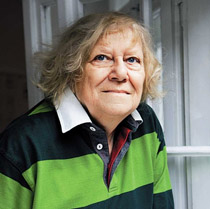
Alena Šrámková will celebrate her 90th birthday
 |
The list of her works is extensive, and the character of her designs is very diverse, ranging from a chemical plant to a hotel interior, locally from Wenceslas Square in Prague to the empty hill above Cheb (meteorological station) to a forest solitude. However, her handwriting remains legible. Šrámková claims that a house has its obligations towards humanity in general – it must not frighten, shock, or dazzle people; it must be honest and strong enough to influence them.
The architect is among the representatives of so-called Czech severity, as architectural historian Rostislav Švácha characterized a group of creators who are inclined towards minimalist tendencies.
The ČKD seat on Wenceslas Square (1983), which Šrámková designed together with her husband Jan, reacted to contemporary events in foreign architecture. In the stagnant normalization environment, the building then became a kind of symbol of the thaw. The postmodern "revelation" with large clocks slightly set into the center, however, sparked discussions long after its completion. The ČKD building served until the end of the 1990s; Šrámková later participated in the reconstruction of the protected structure.
Among her other works (realized or projects) besides the Prague railway hall (1977), which she designed with three colleagues, are the cultural center Lužiny (with Ladislav Lábus), a small tower for a researcher in Košík, the meteorological station Šerák, Hypobanka on Republic Square, a footbridge in Holešovice, and a house with a care service in Horažďovice. More recently, there is the new Tyrš Bridge in Přerov (2012), the brewery in Olomouc (2007), and the building of the Faculty of Architecture of CTU in Dejvice (2011).
Šrámková was born on June 20, 1929, in Prague. She studied at the Technical University in Bratislava and the Academy of Fine Arts in Prague in the studio of Jaroslav Fragner. She then passed through several design offices, and in the late 1980s, she worked in the SIAL studio, which under the leadership of Karel Hubáček represented one of the few distinctive and original currents of Czech architecture since the 1960s.
In 1992, she founded her own studio (Šrámková architects), where she worked with two colleagues. The studio participated in numerous competitions, often winning or receiving awards, but some of its buildings remained only on paper. Šrámková never felt the need to measure herself against the current "trends".
A certain "intractability" or radicality in her thinking is attractive even to her younger colleagues, whom she has been teaching at the Czech Technical University in Prague since 1991 (as a professor since 1999). Šrámková was the first chairwoman of the Council of the Architects' Association after 1989. The organization awarded her the Prize for Personality in Czech Architecture in 1994. In 2008, she received from President Václav Klaus the Medal of Merit for Contribution to the State in Culture and Arts and the Honor of the Czech Chamber of Architects for 2007 for her contribution to modern Czech architecture.
The English translation is powered by AI tool. Switch to Czech to view the original text source.
0 comments
add comment
Related articles
1
10.03.2022 | At the age of 92, architect Alena Šrámková passed away today
1
04.01.2020 | To the exhibition of Alena Šrámková at Museum Kampa
0
18.11.2019 | House on Wheels - a gift for Alena Šrámková
0
25.10.2019 | Šrámková selected 17 of her favorite buildings for her exhibition
0
17.10.2019 | Alena Šrámková: Architecture - invitation to Museum Kampa











